 All Our Tours
All Our Tours
Written by: Vicky Nguyen
Updated date:05/08/2025
Hello, I’m Vicky! As a passionate travel enthusiast and tour planner at Asia Viva Travel, I’ve gathered extensive experience traveling across Vietnam and other captivating destinations in Southeast Asia. Now, I’m thrilled to share these adventures with you through my blog. From my journeys, I’ve gained a deep understanding of the unique cultures, hidden gems, and unforgettable experiences that this region has to offer. My goal is to bring you authentic and practical insights to help you design your own remarkable adventures. Join me, and let’s discover these extraordinary places together!
Contents
Hanoi, the dynamic capital of Vietnam, offers a captivating blend of time-honored traditions and contemporary living, making it an unmissable destination for tourists exploring Vietnam. A journey through Hanoi is a sensory experience, where the echoes of the past resonate amidst the energy of modern life. Hanoi’s charming fusion of ancient history and modern progress creates a unique and unforgettable atmosphere, solidifying its status as a must-see destination for any traveler seeking an authentic Vietnamese experience. The city’s unique character and cultural richness promise an unforgettable journey for all who visit.
Hanoi Vietnam is the capital and second-most populous city of Vietnam. The name “Hanoi” translates to “inside the river” – Hanoi is bordered by the Red and Black Rivers. Hanoi is located in the northern part of Vietnam, specifically in the Northeast region.
Hanoi is the cultural, economic, and educational hub of Northern Vietnam. As the nation’s capital, it is home to 78 foreign embassies, the headquarters of the People’s Army of Vietnam, Vietnam National University, and numerous governmental institutions.The city boasts iconic landmarks such as the Imperial Citadel of Thăng Long, Ho Chi Minh Mausoleum, Hoàn Kiếm Lake, West Lake, and Ba Vì National Park on its outskirts. Its urban landscape features a mix of French colonial architecture, socialist-era brutalist buildings, and bustling alleys with tube houses reflecting its rapid 20th-century growth.
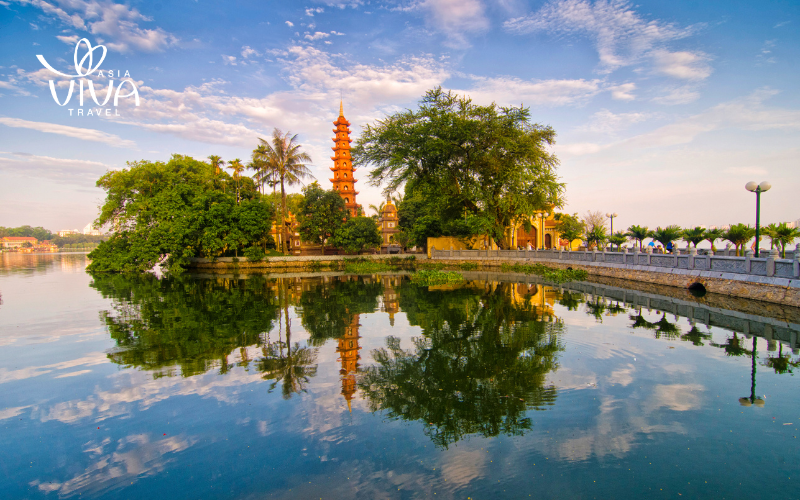
Hanoi – A vibrant picture of sceneries and people
Hanoi gracefully blends the charm of its ancient past with the vibrant pulse of modern life. Walking through the narrow, tree-lined streets of the Old Quarter, you can feel the city’s rich history in the timeworn architecture and quiet, hidden courtyards. Yet, just around the corner, sleek cafés and boutique shops reflect a lively, contemporary energy. At Hoan Kiem Lake, the iconic Turtle Tower stands proudly amidst the tranquil waters, while locals and tourists alike stroll the surrounding park, capturing the perfect balance between tradition and urban sophistication.
Vietnam is located in a tropical climate zone, which is usually hot, humid, and rainy. However, unlike Ho Chi Minh City, which has two seasons: the dry season and the rainy season, Hanoi experiences the full beauty of all four seasons. Therefore, tourists can visit Hanoi at any time of the year by following this season schedule:
The most beautiful season in Hanoi is autumn, which lasts from September to November. During this time, Hanoi’s temperature is quite cool, pleasant, cloudy and not excessively hot. That makes Hanoi more poetic and charming, creating a unique beauty of Hanoi.
In addition, summer in Hanoi can be quite hot, with temperatures reaching up to 39 degrees Celsius, so tourists should prepare their clothing carefully and apply sunscreen thoroughly. Although each time of the year, Hanoi’s weather is always pleasant, there will be many activities to experience. Some tourists have to experience hot weather in Vietnam, but in Hanoi there will always be reasonable activities both indoors and outdoors for visitors to experience.

Best time to visit Hanoi
Hanoi is easily accessible by air, train, and road. Most foreign tourists arrive via Hanoi Airport – Noi Bai International Airport, which hosts both domestic and international flights. Major domestic airlines such as Vietnam Airlines, Vietjet Air, and Bamboo Airways offer frequent connections, while international carriers like Emirates, Singapore Airlines, and IndiGo also serve Hanoi. For affordable fares and convenient flight times, it’s recommended to book tickets at least three months in advance. Additionally, travelers can reach Hanoi from other cities in Vietnam by taking domestic flights, trains, or via the national highway and expressway network. Below are the estimated flight times from various domestic locations to Hanoi and the range of flight ticket:
Travelers should note that airfare prices may vary depending on the time of purchase, promotional programs, class of service, accompanying services, exchange rates, etc. Additionally, flight duration may be affected by weather conditions and the airline you choose. If travelers are planning a long trip to Vietnam, consider checking out a Vietnam tour package from Asia Viva Travel to save on travel costs and make your trip more convenient.
As a popular tourist destination, Hanoi offers a variety of accommodation options for visitors to choose from according to their needs. Typically, for convenience in transportation and comfort in resting, travelers may consider staying in 3-4 star hotels in Hanoi. These hotels are usually located in the city center, making it easy to get around, and visitors can expect quality service to have a quality time for relaxation. Hotels will always warmly welcome visitors with complete facilities, including restaurants, swimming pools, spas, gyms, etc., depending on their accommodation choice. Through inspection trips, Asia Viva Travel has helped hundreds of travelers find suitable places to stay with a list of Hanoi hotels that we survey and update annually.
The price for 1 night stay in Hanoi hotels would range from 500.000 VND to 3.500.000 VND ( 20 USD to 141 USD)
When you arrive in Hanoi, there will definitely be many interesting attractions that visitors should check out to admire the beauty of historical time harmonizing with modern beauty. Additionally, the street scenery of Hanoi in each season has its own unique charm; come and enjoy the peaceful atmosphere of Hanoi and experience the exciting activities suggested below.

Things to do in Hanoi
Hanoi’s Old Quarter is one of the places that any visitor must go to when in Hanoi. This area is located right in the city center, surrounded by famous tourist attractions. The Old Quarter consists of 35 streets, each with its own unique characteristics. Visitors will notice a common feature and realize they are in the Old Quarter, as almost all the streets begin with the word “Hàng,” which means “offers” in English. Historically, the Old Quarter was a gathering place for many craft villages outside of Hanoi, with each street specializing in a specific product, such as fabrics, medicines, or wooden goods. In addition to enjoying the peaceful yet bustling life, you will also see ancient houses and villas that are hundreds of years old here, and some houses are tucked away in alleys, serving as interesting hidden gems that visitors should not miss.
The Old Quarter of Hanoi is also a place where the ancient beauty of Vietnam blends with French architecture, featuring famous landmarks such as the Opera House and St. Joseph’s Cathedral.
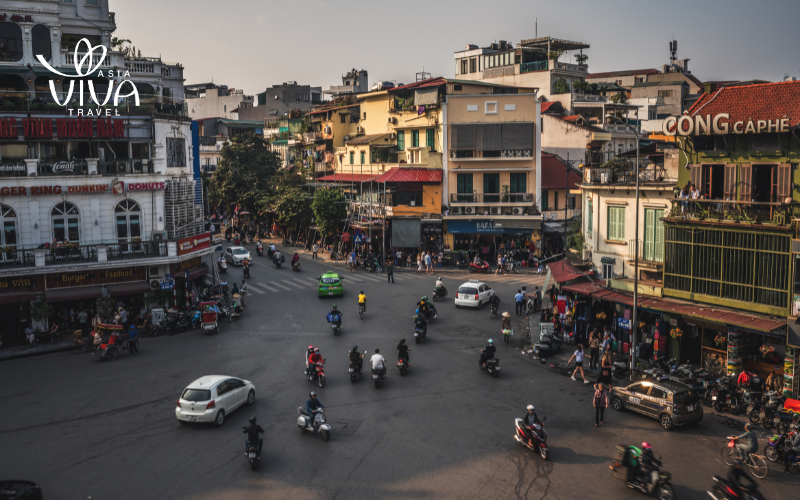
Hanoi Old Quarter
The Ho Chi Minh Complex includes the Ho Chi Minh Mausoleum, the Presidential Palace, the residence and workplace of the late President Ho Chi Minh, the Ho Chi Minh Museum, and the One Pillar Pagoda. This is not only a site that many Vietnamese people visit, but we are also very happy and proud to have many international friends come to visit and pay their respects to President Ho Chi Minh. Here, after visiting the Ho Chi Minh Mausoleum, tourists can explore his residence and workplace to see his simple lifestyle or visit the Ho Chi Minh Museum.
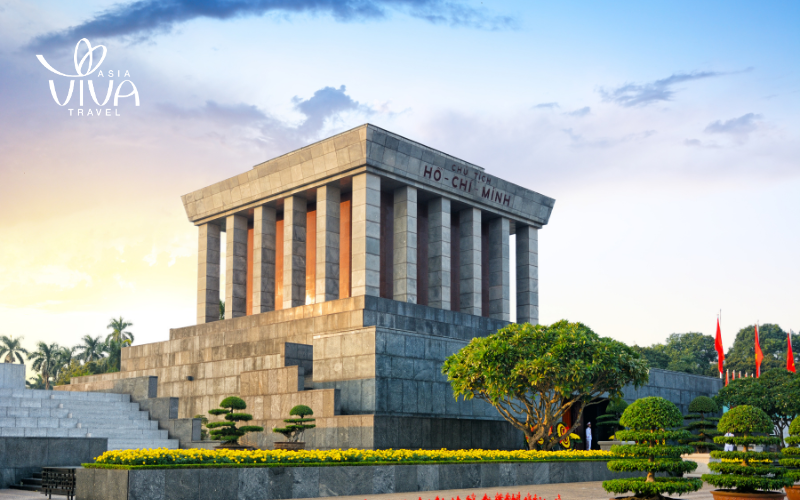
Ho Chi Minh Complex
One of the things that makes the Ho Chi Minh Complex even more special is that within its grounds lies the national heritage site of the One Pillar Pagoda, which was built during the Ly Dynasty in the 11th century. The One Pillar Pagoda impresses with its distinctly Vietnamese architecture and is also a place of worship for Buddha.
This is the first university in Vietnam, a place only for royalty and aristocrats to study during the feudal period. Until now, although this is no longer a place to study, instead it is a place to worship teachers who had been taught here and honor the talented people who passed the Trang Nguyen exam here. The Temple of Literature is not only a place to express the spirit of moral ‘Tôn sư trọng đạo’, which means that students are meant to respect teachers, but also a place to preserve ancient beauty and very dignified infrastructure. You will see the image of the gate named “Khue Van Cac” which is extremely familiar because this was chosen as a symbol of Hanoi and printed on the 100,000 VND banknote.
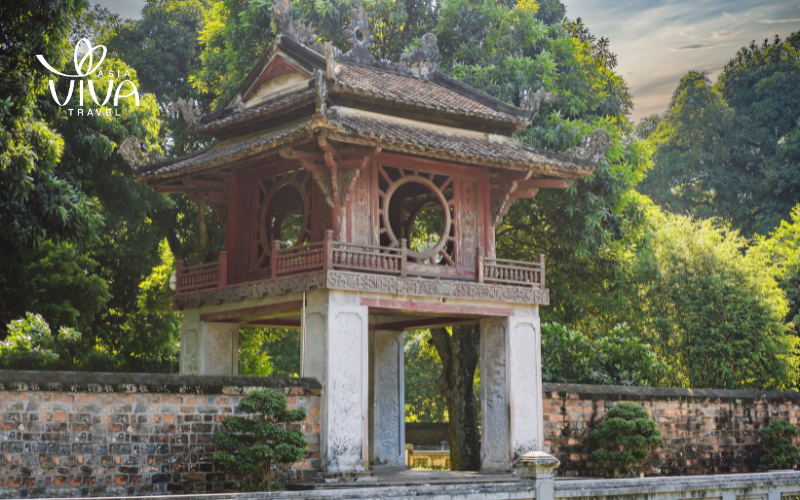
The temple of Literature
Thang Long Imperial Citadel, is a valuable historical relic located in the center of Hanoi, recognized by UNESCO as a World Cultural Heritage in 2010. This is a massive architectural complex, bearing the mark of the feudal dynasties of Vietnam throughout more than 1,000 years of history. Currently, this is a place to display many antiques from the past under the feudal period, sometimes there are also special topics on the theme of the dynasties, war. In addition, if visitors are a lover of ancient costumes, traditional costumes of Vietnam, then at the Thang Long Imperial Citadel campus there is a service to rent ancient costumes, with the scenery of the imperial citadel, this is the place very suitable for costumes.

Thang Long Imperial Citadel
The Hanoi Flag Tower or Tower of Hanoi is a prominent historical monument located at 28 Dien Bien Phu Street, near the Ba Dinh area. Built in 1812 during the reign of King Gia Long, the flag tower stands about 33 meters tall and symbolizes the power of the Nguyen dynasty. Situated within the grounds of the Thang Long Imperial Citadel, this site not only holds deep cultural significance but also attracts tourists, showcasing the history and traditional architecture of Hanoi.
Hoa Lo Prison, also known as the “Hanoi Hilton” during the Vietnam War, is an important historical site in the center of Hanoi. Built by the French in the late 19th century (1896), Hoa Lo was originally used to detain Vietnamese revolutionary soldiers during the struggle for independence under the name “Maison Centrale”.
Hoa Lo Prison has a solid architecture with high walls, a system of narrow cells and harsh living conditions. This is the place that witnessed many important historical events and the indomitable spirit of patriotic prisoners who fought bravely against the oppression of the colonial regime.
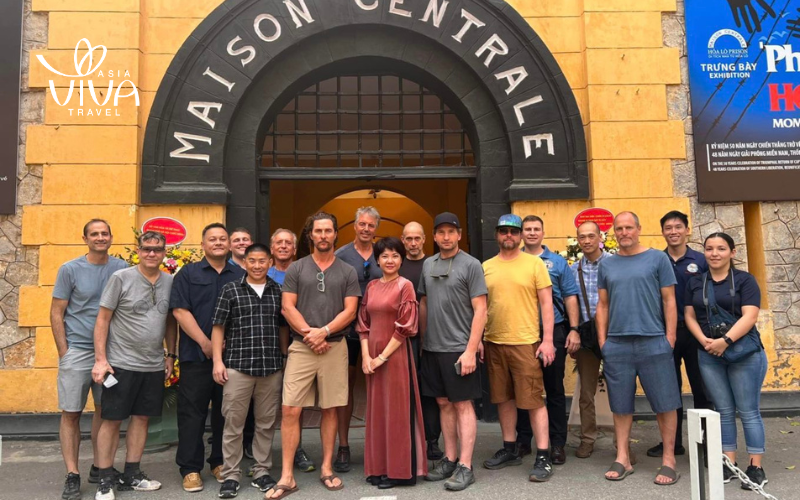
Hoa Lo prison
Currently, Hoa Lo Prison has become a museum, attracting domestic and foreign tourists. It displays many artifacts, images and documents related to the history of the prison, helping visitors better understand the important stages of the struggle for national liberation. To make it easier for visitors to learn about this attraction, visitors are encouraged to use an audio guide. Please request to rent this device when purchasing tickets at the ticket counter.
Hanoi’s Train Street is one of the unique destinations that attracts tourists by the strange combination of daily life and train tracks. Some such streets in Hanoi include Phung Hung, Ly Nam De and Le Duan, which are famous for the scene of trains running right next to houses just a few meters away. What’s special is that although the train runs right next to the houses, people still live, trade and go about their daily activities as usual.
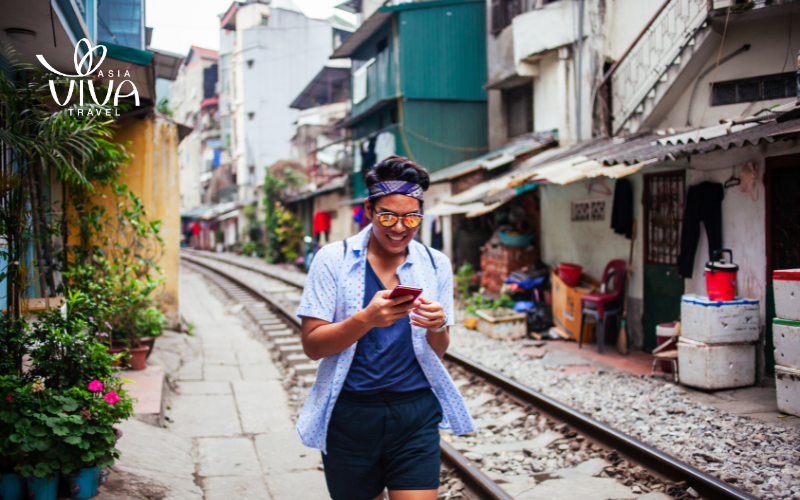
Hanoi train street
Tourists come here not only to experience the thrill of the train passing by, but also to enjoy coffee at small roadside shops and watch the daily life of local people. Hanoi’s Train Street has become a favorite check-in spot for those who want to find new experiences and a different perspective on the vibrant urban life of the capital. However, before visiting, be sure to check the train schedules in advance. Keep in mind that access to the area is restricted during train passages, and visitors are required to follow safety regulations. Due to the frequent train traffic, it may not always be possible to visit certain parts of the area.
If visitors want to see Hanoi with a peaceful beauty, they can spend time walking around the two famous lakes, Hoan Kiem Lake and West Lake. With Hoan Kiem Lake located in the city center, known as the heart of Hanoi, you will see the simple life of Vietnamese people with activities such as exercising and chatting. If you have enjoyed the beauty of Hoan Kiem Lake in the morning, visit West Lake in the afternoon, because the lake has a large area, to go around West Lake is about 18km, so you can go around by rented bicycle or visit the cafes by the lake to watch the beautiful sunset.

Hoan Kiem lake
The National Museum of History, located in the heart of Hanoi, is one of the most important museums in Vietnam, displaying and preserving many valuable artifacts about the country’s history from prehistoric times to the present day. The museum was formed from the merger of the Vietnam History Museum and the Vietnam Revolution Museum, giving visitors a comprehensive view of the development process and important turning points of Vietnam’s history.

National history Museum
The main building of the National Museum of History is an impressive architectural work built in the Indochinese style in the 1920s, with a harmonious blend of French architecture and Vietnamese traditions. The museum displays more than 200,000 artifacts, including antiques from the Dong Son culture period, relics from the Ly, Tran, Le dynasties, and many artifacts from the period of the struggle for independence and resistance against France and the US.
Vietnam Military History Museum is one of the most important museums in Vietnam, located in Hanoi. Established in 1956, the museum preserves and displays many artifacts and documents about the struggle of the Vietnamese army and people through the wars for independence, especially in the two resistance wars against France and the US.
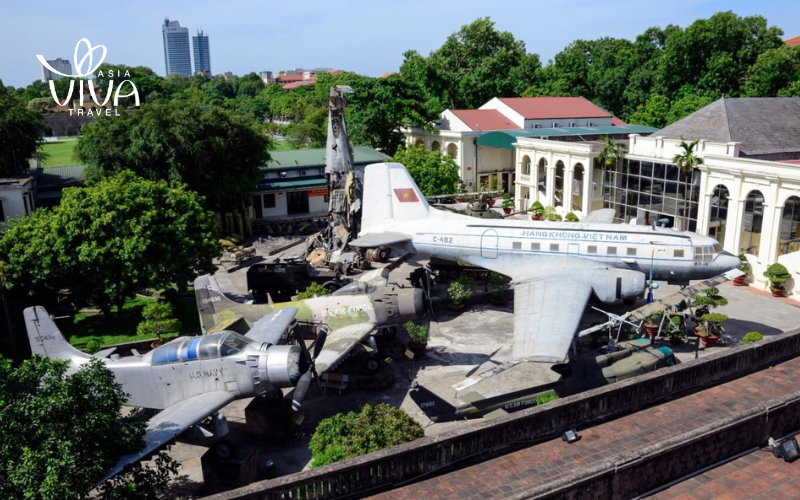
Vietnam Military History Museum
Located at 28A Dien Bien Phu, near the Hanoi Flag Tower – a historical symbol of the capital, the Vietnam Military History Museum includes many exhibition spaces, including outdoor and indoor areas. Typical artifacts include aircraft, tanks, anti-aircraft guns, military vehicles, and many weapons and military equipment used in historical battles. In particular, the museum also displays part of the wreckage of an American B-52 plane shot down during the Dien Bien Phu air campaign in 1972.
Water puppet performance is one of the unique traditional art forms of Vietnam, with a history dating back over 1,000 years. Originating in the rural areas of the Northern Delta, water puppetry was originally a form of entertainment for farmers during festivals, especially when the fields were flooded after the harvest.
The uniqueness of water puppetry lies not only in the familiar folk tales, but also in the accompanying traditional sounds and music. The main musical instruments in the performances are the monochord, zither, drums, gongs and folk songs, creating an artistic space that is both magical and imbued with Vietnamese culture.
Water puppetry performances often take place at large theaters such as the Thang Long Water Puppetry Theater (Hanoi), the Vietnam Water Puppetry Theater, and other cultural tourist attractions. This is an exciting entertainment activity, offering a unique experience and helping visitors understand more about the culture, beliefs and life of Vietnamese people through each vivid puppet on the water.

Vietnamese-Water-Puppet-Show-Hanoi-Vietnam
To offer visitors a truly unique experience and a deep understanding of Vietnam’s traditional culture, Asia Viva Travel has designed an exceptional program -a journey through the traditional villages of Northern Vietnam. By joining the Tonkin Countryside tour in Hung Yen province, travelers will immerse themselves in the charm of local crafts. Visitors will explore vibrant flower villages, learn the delicate art of making incense, and try your hand at weaving bamboo baskets, all while experiencing the everyday life and skills passed down through generations. This tour is a perfect blend of cultural enrichment and hands-on discovery.
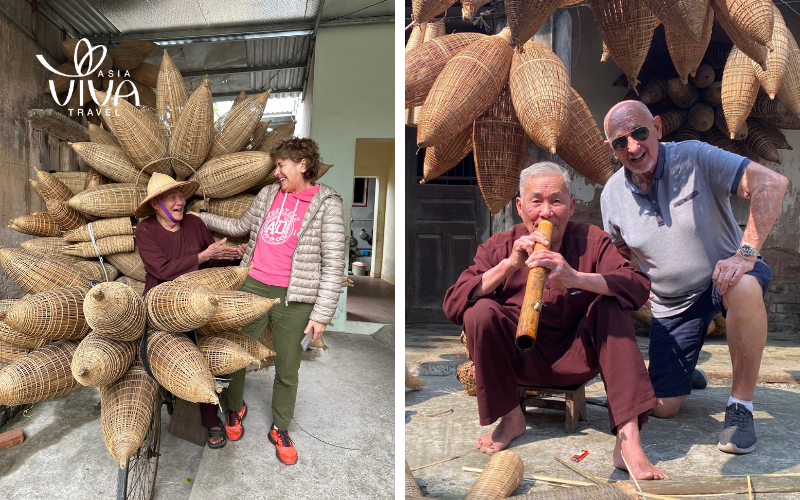
Visit Tonkin village and making traditional crafts
If your time in Hanoi is a bit limited, you can experience a tour around the city on a Jeep or Vespa. Most of these tours can cover some famous places such as the Opera House, Hanoi Old Quarter, West Lake, etc. More specifically, the tour will also have interesting activities such as: enjoying Hanoi specialties such as Bun cha ( grilled meat and rice noodles) or pho roll and egg coffee; visiting bustling local markets to understand the life of Hanoi people. The length of the tour will depend on the places you visit, so please refer to the places you want to go to first.

Hanoi city tour by Jeep
Bat Trang, a famous pottery village over 700 years old in the suburbs of Hanoi, is about an hour’s drive from Hanoi. This is a famous village that always attracts tourists with its sophisticated ceramic art. Here, you will experience the process of making your own pottery: starting from kneading clay, shaping on a turntable, editing details, and then decorating the product with patterns as desired. After that, the product will be fired to completion, creating a unique memory from your visit to this traditional craft village. The firing time can sometimes be quite long, up to 1 day, but it will be sent to the tourist’s hotel so that it can be taken as a souvenir of Vietnam.

Making pottery at Bat Trang village
With the guidance from Asia Viva Travel, you’re now equipped with helpful tips to make the most of your visit to Hanoi Vietnam. Whether you’re exploring the vibrant markets, strolling around historic sites, or savoring the local cuisine, we hope these insights enrich your journey and deepen your connection to the city. Get ready to immerse yourself in Hanoi’s captivating atmosphere and create unforgettable experiences!
At Asia Viva Travel, we are committed to supporting society, especially in Vietnam’s remote regions. By traveling with us, you help support local tourism workers and contribute to building schools and providing free lunches for disadvantaged children in North Vietnam’s mountains. Join us to help build a better future for Vietnam’s children and vulnerable communities in the “Nuôi em” project .

 26/11/2025
26/11/2025A travel guide with tips for first time travellers to Vietnam covers everything from getting a visa, Internet, SIM Cards, tipping and how to get around, survival tips and more

 26/11/2025
26/11/2025Visiting Cambodia and Vietnam for stunning landscapes, vibrant cities, ancient temples, and UNESCO World Heritage sites is a complete travel experience for tourists.

 26/11/2025
26/11/2025Visit Da Nang with our detailed guide to the best hotels, resorts, Michelin-starred restaurants, and local street food for an unforgettable Vietnamese getaway.

 26/11/2025
26/11/2025Discover the best Vietnam tour packages from USA and enjoy a safe, unforgettable journey through Vietnam’s culture, beautiful nature, and rich history.